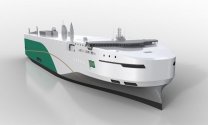I am referring to the fact that SK's shipyard orders exceeded that of China Q1 and could possibly continue for the year
Even before this news China and SK were pretty even, not like the dominance China has in many other industries.
The GT article notes that this is based on Compensated Gross Tonnage (CGT) instead of Gross Tonnage (GT). CGT multiplies the GT of each ship produced by a coefficient based on the type and size of ship. The conversion formula from GT to CGT is: CGT = A * (GT^B).
| Ship Type | A | B |
| Oil Tankers (Double Hull) | 48 | 0.57 |
| Chemical Tankers | 84 | 0.55 |
| Bulk Carriers | 29 | 0.61 |
| Combined Carriers | 33 | 0.62 |
| General Cargo Ships | 27 | 0.64 |
| Reefers | 27 | 0.68 |
| Full Container | 19 | 0.68 |
| Ro Ro Vessels | 32 | 0.63 |
| Car Carriers | 15 | 0.70 |
| LPG Carriers | 62 | 0.57 |
| LNG Carriers | 32 | 0.68 |
| Ferries | 20 | 0.71 |
| Passenger Ships | 49 | 0.67 |
| Fishing Vessels | 24 | 0.71 |
| NCCV | 46 | 0.62 |
In the article it notes that Chinese shipyards have been focused on the construction of oil tankers, bulk carriers and container ships. It also notes the SK shipyards have an advantage in LNG ship construction.
Comparison using 10,000 GT:
Oil Tankers (Double Hull) CGT = 48 * (10000)^0.57 = 9146
Bulk Carriers CGT = 29 * (10000)^0.61 = 7987
Full Container CGT = 19 * (10000)^0.68 = 9971
LNG Carriers CGT = 32 * (10000)^0.68 = 16793
LPG Carriers CGT = 62 * (10000)^0.57 = 11813
If a Chinese shipyard constructed 20,000 tonnes weight for a bulk carrier than it would count for less than 10,000 tonnes weight constructed for a LNG carrier.
Here is Gross Tonnage ship production for comparison:
| 2014 | 2015 | 2016 | 2017 | 2018 | 2019 | 2020 |
| China | 22 851 302 | 25 275 424 | 22 365 449 | 23 682 160 | 23 259 789 | 23 074 209 | 23 257 200 |
| Japan | 13 392 130 | 12 899 210 | 13 363 959 | 13 113 388 | 14 440 056 | 16 241 929 | 12 827 375 |
| South Korea | 21 871 925 | 23 756 983 | 25 455 551 | 22 616 947 | 14 633 292 | 21 670 363 | 18 173 891 |
Chinese ship production by Gross Tonnage has held fairly steady at 23,000,000 tonnes per year since 2017.
The article also notes that rising steel prices are a major concern. Prices of raw materials likely affect less complex ships with lower price margins more. In July 2020 the Shanghai steel futures were trading at ~3,700 CNY per ton. Right now July 2021 Shanghai steel futures are trading at ~4900 CNY per ton. The peak was ~5960 CNY per ton in May 2020. No shipyard wants to build ships at a loss.
Higher steel prices may not be all bad. It provides a strong incentive for shipyards to cut costs, improve efficiency and move up the value-added manufacturing chain. Looking at it from a national perspective, higher steel prices can help firms determine which products won't be economically viable. i.e. Would you rather spend the steel constructing ships or new wind turbines? A wind turbine is 71% - 79% steel by mass. In 2020 China had 282,650 MW of wind power capacity, an increase of 72,600 MW from 2019. For comparison South Korea had 1,600 MW of wind capacity in November 2020.


